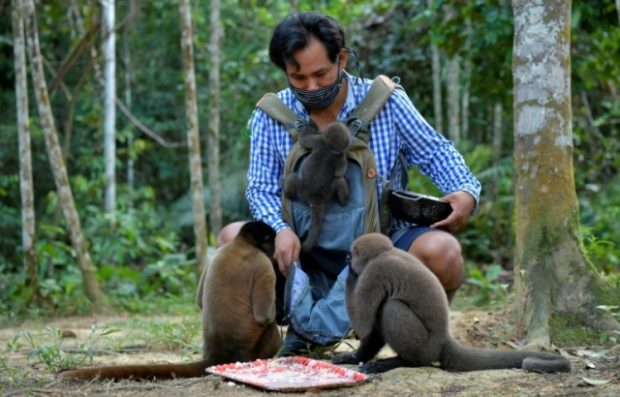
Woolly monkeys (Lagothrix lagotricha) surround the director of the Maikuchiga foundation, Jhon Jairo Vasquez, in the indigenous community of Mocagua, near Leticia, Colombia. Image: AFP/RAUL ARBOLEDA.
Far from the rifle cracks that occasionally rip through the rainforest as local tribesmen hunt mature primates for their meat and soft pelts, a sanctuary in a corner of the Colombian Amazon is offering new life to the orphaned monkeys left behind.
The refuge run by a local leader, Jhon Jairo Vasquez, is giving them a second chance — while gradually changing attitudes in the area — in the indigenous settlement of Mocagua on the banks of the Amazon.
Vasquez has proved to be a father figure for one of the orphans, a three-month-old female woolly monkey, or Lagothrix, he’s named Maruja.
The pair have become inseparable on his hikes through the rainforest, carrying the little primate in a sack on his back.
“I have become the father, and she’s become the daughter,” said Vasquez, 38.
“An indigenous family ate the mother.”
Prized and vulnerable
Long prized by indigenous hunters for their meat and furry pelts, the woolly monkey is now classified by the International Union for the Conservation of Nature as Vulnerable, appearing on the IUCN’s Red List of Threatened Species.
Given their thick brown coat and grey appendages, young woolly monkeys like Maruja are often hunted for the pet trade, with their mothers sometimes killed in the process.
Fourteen years ago, Vazquez helped found the Maikuchiga animal refuge located in the middle of the 700-strong Tikuna indigenous community in Mocagua.
Since 2006, he has been trying to convince locals of the damage caused by “over-hunting,” as well as a flourishing illegal wildlife market.
“It’s hard,” he said.
Reluctant at first, the Tikunas have developed a taste for eco-tourism. “Rehabilitated” hunters have become guides who now “protect their wildlife,” said Vasquez.
But traumatized orphans continue to arrive in Maikuchiga from other parts of the Amazon. Since its creation, the refuge has rehabilitated about 800 monkeys, according to Vasquez.
The community is located at a spot in the Amazon called the Triple Frontier, where Peru, Colombia and Brazil meet.
There is a long history of monkeys being hunted here for meat or for ritual purposes.
They are still shot from trees, mother and baby entwined as they fall, said Vasquez.
“The mother does not let go of her baby. And the little one falls attached to its mother. Sometimes, the pellets can injure or even kill it.”
The adult’s flesh is roasted on a wood fire, as the meat is prized.
The small survivors are sold as pets or exhibited to tourists visiting the indigenous communities of the Triple Frontier region.
The lucky ones are rescued by Corpoamazonia, the Colombian government agency in charge of environmental protection, based in nearby Leticia.
Luis Fernandez Cuevas, its director, said 22 young primates have been recovered since 2018.
Sometimes these are the result of “voluntary surrenders” by people who claim to have found them by chance, in order to avoid an investigation for trafficking or illegal possession of the animal.
In Colombia and neighboring Brazil, it’s illegal to remove any animal from the wild to keep as a pet.
Monkey business
Vasquez looks after five other primates here: the woolly monkeys Helena and Abril, an owl monkey (Aotus) called Papinanci, and two squirrel monkeys (Saimiri sciureus), Mochis and Po.
“Here, they are given a new opportunity in life, the opportunity to become monkeys again,” he said.
But Maikuchiga is financed by tourism and the COVID-19 pandemic has hit the region hard, choking off tourist dollars for the locals and resources for the refuge.
At dawn, Vasquez prepares a breakfast of oat porridge and vitamins for his charges.
“When they are psychologically traumatized, it can take them a long time to adjust. They can’t see a child, a man… They tremble,” he said.
They will also have to slowly adapt to the wild, to know how to recognize “the sounds of danger” from the jungle and the habits of predators.
Rehabilitation for these monkeys comes to an end when they leave the 4,000 protected hectares of Mocagua.
Little by little, they find their way through the trees and move in packs, learning what their mothers could not teach them.
“We realize that they have completed their rehabilitation when they disappear,” said Vasquez. CC
RELATED STORIES:
Peru’s untouched indigenous tribes facing growing threats
Deforestation wiped out 8% of Amazon in 18 years – study